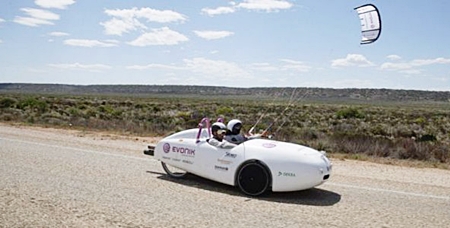The Wind Explorer has just set some sort of a record by crossing Australia in something akin to a kite-board on wheels.
A TV host and an engineer from Germany have completed an almost 5,000 km journey in their Wind Explorer, which is a lightweight electric vehicle powered by the wind – not only through electricity-generating wind turbines but also using kites.
The 18 day trip by Dirk Gion and Stefan Simmerer set three world records – the first time a continent has been crossed be a wind-powered vehicle, the longest overall distance covered by an exclusively wind-powered land vehicle, and the longest distance covered by such a vehicle in 36 hours.
 Wind Explorer
Wind Explorer
Wind Explorer is a prototype electric vehicle, and the secret of its success is in the light weight. The entire vehicle, including the battery pack weighs only 200 kg.
The construction is of an aluminium frame covered by a carbon-fiber sandwich material and the vehicle runs on bicycle tyres.
The battery is an 8kWh lithium-ion pack that was recharged every night using a portable wind turbine on the top of a six meter high telescopic bamboo mast – but they did use the domestic electric grid on nights with no wind.
On January 26 of this year, Wind Explorer left Albany, on the southern coast of Western Australia. For the first 800 km, the vehicle was powered entirely by electric power.
Once they got to the Nullarbor (“no trees”) Plain the intrepid pair were able to take advantage of the strong winds to use kites to drag the vehicle along, as is done with kite-boarding. The passenger held on to the large steerable kite similar to a parasail. Apparently it was not easy, but they did manage to cover several hundreds of kilometers crossing the desert.
The trip took the Wind Explorer through the states of Western Australia, South Australia, Victoria and New South Wales, arriving in Sydney on February 14. On the trip the vehicle reached speeds of 80 km/h. The best daily distance covered was 493 km.
The journey was not without drama and punctures, including blowing two motors, but I suppose, like climbing Mt. Everest, they can say they have done it. They believe that they have proved that the technology is already available to produce self-sufficient and environmentally sound transport; however, they did not prove whether it was at all practical.




